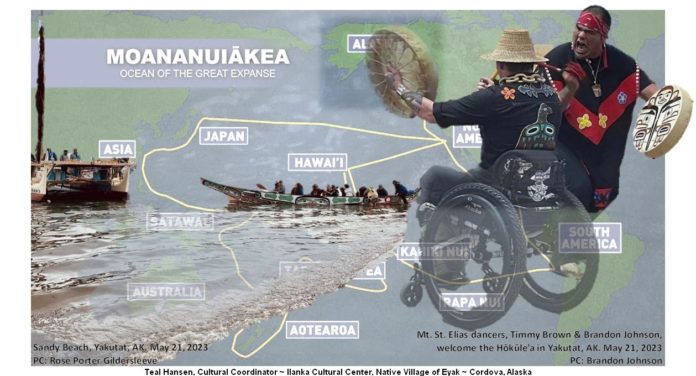By Teal Hansen
In May, the Polynesian voyaging canoe Hōkūle’a (“Star of Gladness” named for Arcturus, the zenith star of Hawai’i) journeyed nearly 30 hours from Juneau, through the Gulf of Alaska, and arrived in Yakutat, her first stop in the Alaska Heritage Sail and the furthest north the canoe has ever voyaged.
In the Yakutat region prior to outside contact, the Tlingit and Proto-Athabaskan-speaking Eyak were in the process of melding two distinct cultures creating the Yakutat Tlingit, combining Eyak, Athabaskan, and Tlingit identities with the Lingít language and a largely Tlingit social organization. The close relationship with the Eyak is reflected in the name “Yakutat,” itself. The name is Tlingit, Yaakwdáat (“the place where canoes rest”), but originally derives from an Eyak name Diya’quda’t, or Ya.gada.at (“a lagoon is forming” [from the glacier’s retreat]), and was influenced by the Tlingit word yaakw (“canoe, boat”). The intersection and ultimate integration of these two groups is the result of a northward expansion by the Tlingit into the Yakutat area, which had previously been settled by a southerly migrating Eyak. Yakutat maintains traditional Tlingit culture with unique influences from the Eyak and Athabascan.
Yakutat marks the beginning of the Alaska Heritage Sail, a pre-voyage through the Southeast region of Alaska before the global launch of the four-year Moananuiākea Voyage circumnavigation through the Pacific. The Polynesian Voyaging Society (PVS) chose Yakutat to be the first stop on the Alaska Heritage Sail to honor the late Byron Mallott, who was born and raised in our neighboring town of Yakutat. In 1990, under Mallott’s leadership, Sealaska gifted two 200-foot, 400-year-old Sitka spruce trees to Hawai’i to help construct the voyaging canoe Hawai’iloa. This kind gesture, which came at a time of decline of Koa trees, sparked reforestation efforts in Keauhou, Ka’ū on Hawai’i Island, and started the special bond between Alaska’s southeast Native peoples and Hawai’i. The Alaska Heritage Sail will pay homage to Alaska Natives and the places that fostered the 30-year history between Hawai’i’s voyaging community and Alaska.
Byron’s sons, daughter, and granddaughters joined the heritage sail from Juneau to Yakutat, where the crew moored Hōkūle’a in front of Byron’s home in Yakutat to spiritually bring Byron on board and honor him. Other members of Byron’s family joined their relations on board for this special moment, including his wife, Toni Mallott. Yakutat greeted the canoe at their shore on May 21 and received them for the following week while the Polynesian crew engaged with locals. That night, our Mt. St. Elias Raven and Eagle cousins shook their tail feathers and welcomed the Polynesian crew with a powerful dance performance.
Galen Meyer, a Native Village of Eyak Tribal Member whose maternal Tlingit roots originate in Yakutat, and his crew member, local Cordovan Jake Borst, left Cordova for Juneau on Galen’s boat, the Golondrina, on May 14 and met up with the Hōkūle’a crew on May 18. Together, they left Auke Bay in Juneau on May 19 and escorted the double canoe for this portion of their journey through Alaskan waters to Yakutat, arriving on May 20.
The Cordovans commented on the once in a lifetime opportunity connecting with the crew and getting to experience the cultural exchanges between the two Indigenous groups. Afterwards, they waited for a weather window before setting off for Hoonah. Starting June 15, the Hōkūle’a will sail 43,000 miles, moor in 345 ports, and visit 36 countries with a total of 150 indigenous populations. The aim of the Moananuiākea Voyage, meaning a voyage for Earth, is to begin a healing process by visiting these communities and help repair the earth with education about why it’s so important to take care of the earth.
The PVS’s website states: “Moananuiākea is Hōkūleʻa’s 15th major voyage in her first 50 years. At the core of Hōkūleʻa’s creation was exploration – to uncover, recover, and reclaim. Reclaim our culture, traditions, and our relationship to home and our island earth. Moananuiākea is no different, but we are now guided by what the worldwide voyage told us – that we must deepen our values in the voyage and move from exploration and understanding to mālama, or caring, and kuleana, or taking responsibility. With those values, we must move discovery toward choices and actions that we believe will help build a future good enough for our children. This is our most difficult voyage yet because the destination is not ours. It will be the most difficult island yet to find, because it is the future of island earth.”
Sailing with Hōkūle’a is a virtual canoe Wa’a Honua (“Canoe for the Earth”) that can be followed online.
Information gathered from the Hōkūle’a Crew came from https://www.facebook.com/hokuleacrew and http://www.hokulea.com. Historical information gathered primarily from Frederica de Laguna’s documentation.
Teal Hansen is the Cultural Coordinator at the Ilanka Cultural Center, Native Village of Eyak.
The Native Voices Column is a new Cordova Times section that highlights and uplifts the experiences and culture of the many Native populations that make up our community through guest contributions to the paper. If you are interested in submitting something about your tribe, Village or a Native topic that is important to you, you can email us at share@thecordovatimes.com. The Cordova Times covers and is distributed on the historical and unceded territories of the dAXunhyuu (Eyak people), the Prince William Sound Sugpiaq, and the Yaakwdáat Lingít.






